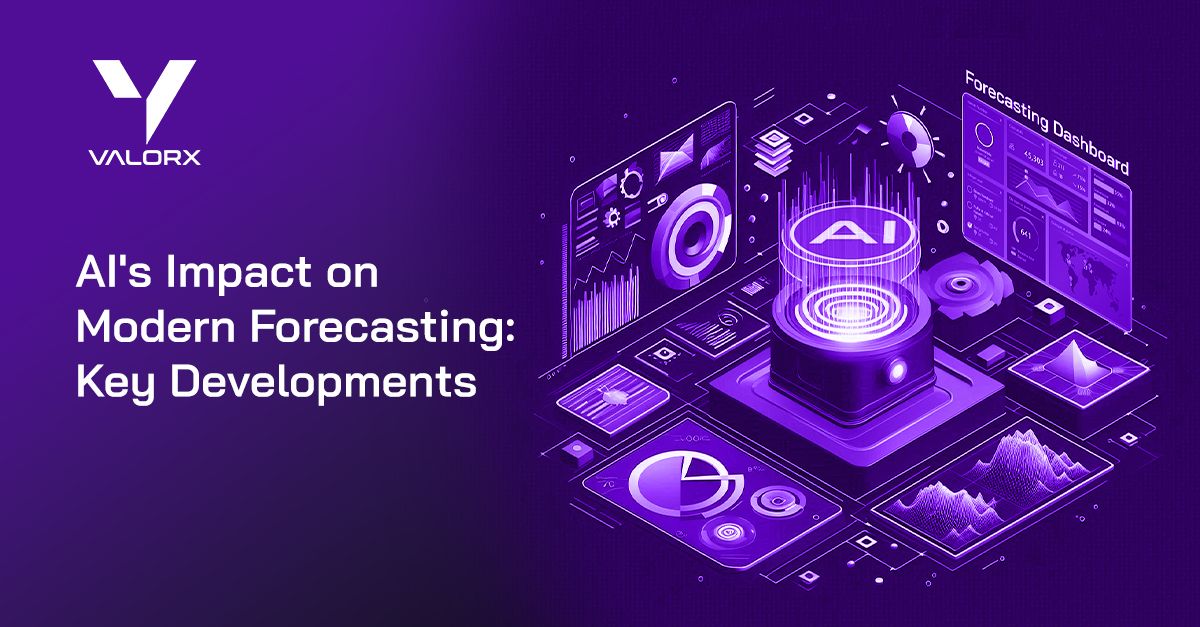Many businesses struggle with demand variability, and studies show that inaccurate forecasts cost companies millions in lost revenue, annually.
Accurate forecasting is crucial for maintaining operational efficiency and staying competitive. For industries like manufacturing, where demand fluctuations and supply chain challenges are constant, even a minor delay in securing materials can halt production lines, leading to missed revenue and increased costs.
Artificial intelligence (AI) and machine learning (ML) have emerged as pivotal tools in predictive analytics. With their help, businesses can improve forecast accuracy and simplify complex workflows.
Why accurate forecasting matters
Accurate forecasting informs both long-term and short-term business decisions. Long-term forecasts guide capital investments, such as expanding production capacity or launching new facilities to meet future demand. Short-term forecasts impact decisions like inventory management and resource allocation.
In a Forecasting Fireside Chat hosted by Valorx, here's what Frank Borovsky explains...
"Forecasting accuracy impacts everything from balance sheets to customer trust. The moment a forecast is off, the ripple effects can be felt across production schedules, supply chain management, and customer relations."
Frank Borovsky, Principal at B2Beyond and B2B tech evangelist
Inaccurate forecasts can lead to costly outcomes: missed sales due to stock shortages or excess inventory that ties up capital. This is something we explore in much more depth in this article.
Challenges with traditional forecasting
Forecasting is critical for strategic decision-making, yet many businesses struggle with outdated tools and low adoption of structured processes. This leads to inefficiencies, data silos, and manual workflows that introduce inaccuracies and delay decisions. Teams often lack trust in data due to disconnected systems and inconsistent processes.
"Many demand planning teams receive data that salespeople don’t fully trust because of disparate sources and inconsistent processes. Without alignment, you're not just missing the numbers - you're missing valuable context that shapes better decision-making."
Mark Schmidt, Senior Director, Salesforce
Key challenges of traditional forecasting methods include:
- Data silos: Outdated systems create inconsistent, untrustworthy data.
- Manual processes: Spreadsheets introduce errors and slow updates.
- Limited collaboration: Isolated workflows hinder cross-team alignment.
These challenges result in reactive rather than strategic forecasting, making it harder to compete in today’s fast-paced markets.
How AI and Machine Learning elevate forecasting
AI and ML enhance forecasting by automating data analysis, identifying patterns, and generating actionable insights. Here’s how they contribute
1. Anomaly Detection - AI systems can quickly detect anomalies in sales trends, orders, and supplier data. By flagging discrepancies early, businesses can investigate and address issues before they escalate.
Chris Lim, Enterprise Solutions Architect at Valorx adds...
"Identifying deviations in real-time prevents costly blind spots. It’s like having a virtual assistant constantly monitoring your data."
Chris Lim, Enterprise Solutions Architect at Valorx
Lim works closely with clients navigating complex forecasting needs, helping them uncover insights and achieve greater accuracy in their decision-making.
2. Real-Time Forecasting - Unlike traditional models that rely on static historical data, AI-driven systems update forecasts as new data flows in, allowing real-time adjustments. This responsiveness is particularly beneficial for short-term planning and inventory optimization.
"The ability to adjust forecasts dynamically keeps production teams ahead rather than playing catch-up," notes Schmidt.
3. Predictive Insights Across Timeframes - AI tools offer adjustable views of forecasts, covering weekly, monthly, and quarterly periods. Salesforce Excel connector Valorx Fusion, for instance, allows users to interact with live Salesforce data through a familiar spreadsheet interface, making it easier to analyze trends across different time horizons.
"The power of a tool like Fusion lies in how it adapts to the needs of various teams, presenting unified insights without forcing users to abandon their preferred workflows," says Lim.
AI in Action: Enhancing forecast accuracy and efficiency
Manufacturers using AI-driven forecasting solutions report tangible improvements. Insights from the webinar revealed the following key benefits:
- Fewer forecast errors: Increased data accuracy and consistent aggregation across sales, operations, and finance.
- Inventory optimization: Better demand predictions reduce excess stock and prevent stockouts.
- Improved cash flow: Smarter resource allocation leads to leaner production cycles and more efficient financial management.
Overcoming adoption barriers
Despite the benefits of AI, implementing AI-enhanced forecasting requires addressing common obstacles:
- Change management: Adoption requires cross-departmental alignment and comprehensive training.
- Data quality: AI models depend on accurate and consistent data inputs.
- Integration: Seamless compatibility with existing platforms, like Salesforce and ERP systems, is essential to prevent data fragmentation.
Salesforce Excel connector Valorx Fusion mitigates these challenges by connecting the Excel interface directly to CRM data, allowing teams to work within a familiar, flexible environment.
"The key to adoption is making tools accessible and valuable to everyone involved, from sales teams to demand planners," says Lim. "If the data isn’t trusted or the interface is too rigid, adoption rates will suffer."
By improving process adoption and ensuring high data integrity, businesses are in the best position to leverage AI capabilities.
The future of forecasting: AI’s expanding role
As AI technology evolves, its impact on forecasting will deepen. Autonomous AI agents that provide recommendations, detect early demand shifts, and optimize production schedules are becoming more prevalent.
"AI tools can handle vast datasets and spot trends that human analysts might overlook," explains Schmidt. "It’s not just about faster analysis - it’s about deeper, more meaningful insights."
Generative AI tools are also improving data visualization, making complex forecasts more accessible to decision-makers.
Borovsky adds, "These innovations make it easier to explain forecasts to stakeholders who may not be data-savvy, turning raw numbers into clear, actionable narratives."
Wrapping Up...
AI and machine learning are transforming forecasting, making it more accurate, efficient, and responsive. For manufacturers and other data-driven industries, adopting AI-enhanced tools is no longer optional - it’s essential.
Tools like Valorx Fusion, which combine familiar interfaces with advanced predictive capabilities, help businesses unlock the full potential of their data and drive smarter operations.
"The goal should always be for the system to deliver more value than the effort required to use it," Schmidt explains. "When that balance is achieved, forecasting moves from being a routine task to a strategic advantage."
In a competitive market where the fastest response often wins the customer, AI-powered forecasting provides a critical advantage for staying ahead.
Want to learn more about how Valorx Fusion can enhance your forecasting capabilities and streamline your data processes?

